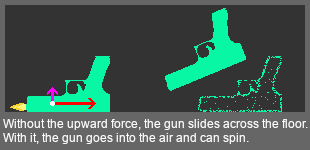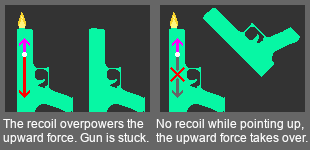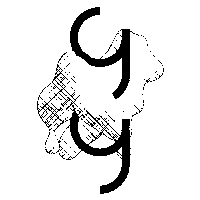A game about possessing guns.
2nd Place – Best Overall Game at Level Up Showcase 2023.
Possession of Weapons is a game in which the player acts as a ghost with the ability to possess firearms. As a ghost they are unable to interact with the guns beyond pulling the trigger, which as well as firing a bullet also sends the weapon flying through the air. They must leverage this recoil to traverse the environment while still using the bullets for their intended purpose.
As a proof of concept, the game is lean on content, consisting of a single level, a single weapon type, and a simple objective, with replayability only in the form of statistics tracking for score chasing. However, polish was a priority in developing it, and bare bones or not, I think it’s a fun way to spend a surprising amount of time figuring out and mastering.
Origin
This was my thesis project for my New Media degree. I was given two semesters to create a project of my choosing, on my own, with an eventual exhibition in an art gallery space, and this is the project I chose.
The primary inspiration for the game is a free shovelware mobile game named Gun Sprint by KAYAC Inc. Gun Sprint has the same primary conceit as Possession of Weapons, where you are a gun and use recoil to move around, but that’s about it. I played Gun Sprint on a whim after seeing an ad for it, and between the constant ads, slow speed, lack of challenge and hyper simplistic level design I quickly came to the conclusion that I liked the core idea, but hated everything around it, and was convinced a much better game could exist around this concept.
Possession of Weapons has a number of secondary influences, but chief among them is SUPERHOT, which inspired the minimalistic visuals and the importance of time manipulation.
Process & Design
Designing the game started with the core gameplay and making sure the concept was actually fun to play around with. This meant making a pistol out of two rectangles, and setting up the linear and angular recoil. From there, it was about tweaking the amounts of everything to levels that felt physically plausible, and from there adding the secondary systems that make the shooting actually feel fun and useful.
First there was adding a constant upwards recoil on top of the primary directional recoil. There’s no physical basis for it, but it makes sure that if the gun is on the ground, shooting will get it off the ground, which allows the player to use the rotational recoil on their next shot to go somewhere. Otherwise, if the gun is sitting with the slide on the ground, barrel parallel to the floor, the player would get stuck just sliding around on the ground. Second was to make the gun only jump upwards if it was on the ground pointing up. Physically speaking, this feels like the gun bouncing off the ground from the downward recoil, but really it’s just to prevent the player from getting stuck in this position, as without the system to catch it, the gun just gets pushed into the ground with each shot.


With this implemented, the shooting felt alright, but controlling anything was very hard, and the idea of actually shooting something while in the air was an absurd ask. This is where the aiming mode came into being, slowing down time so the player can properly time their shots, even when the gun is spinning wildly, pulling the camera out, so the player can see where their shots will take them to, and adding a targeting laser, so the player can see where their bullet will be going.
With the core set out fully, and the numbers tweaked until everything felt natural and controllable, I wanted to set up a proper gameplay scenario so I could get people to test it. I decided to build the level out of small modular pieces so that I could create a bunch of levels more quickly, even though that never panned out due to timing, and I created a basic objective, big targets to shoot, scattered around the level. With the pieces in place, I set up a large semi-linear level that required some exploration and backtracking to complete.
At this point testing began in earnest, pulling friends and classmates in to show them the game and observe them figuring out the unorthodox mechanics. From this testing, I got a ton of really good feedback, and my number one takeaway was that the more unfamiliar a game concept is, the more accessibility needs to be a focus. I had initially planned to make the aiming mechanic limited and recharging, similar to bullet time in other games, but was very quickly pushed away from this after testing. Slowing down time is often necessary just to understand what is going on with your gun, and it was the players who were struggling the most who would be punished by this limitation. There were also tweaks to level design, setting up coloured lights that lead to each target, and a pile of bug fixes to prevent players getting stuck in strange positions.
By this point in development, I was very happy with the core gameplay, and there were a number of testers for whom the physics-based movement “clicked” and they found it very satisfying, but all of the secondary elements, like visuals, audio, and meta elements like menus and tutorialization were severely lacking. The deadline to complete everything for public showing was beginning to loom, and I had a clear choice: should I stop expansion on the core gameplay and polish and set up the supporting elements? Or focus on making more game and let the polish slip to the last minute.
Ultimately I chose to polish, and even though the game ended up being pretty anemic content-wise as a result of this choice (one level, one type of gun) I think it was the correct one. Setting up context dependent tutorial tooltips massively reduced player frustration in figuring out how to interact with the game; making the game a time trial, with different scores reflecting different aspects of mastery massively increased replayability, as testers who struggled to finish the level the first time were often highly motivated to go back and get better times; and setting up dynamic reverb and the sound system massively improved the satisfaction and feedback of hitting obstacles and shooting, turning the levels from empty boxes into genuine cavernous spaces. Without this polish, while the game may have been more content-rich, I think it would have been a lot less successful, as the project was set from the beginning to work primarily as a publicly playable installation like a playtesting booth in a convention.
Takeaways
I think Possession of Weapons as a prototype was a solid success, the feedback on the final product was positive across the board, and there were a solid number of people in both places I exhibited it who became highly engaged, coming back multiple times to finish the level and improve their times. At Level Up Showcase 2023, I had no decoration for my booth compared to other teams, just a monitor on a table, and it was very gratifying to see the number of people visiting my booth increase over the course of the event as word of mouth spread. The award I won, 2nd place for best overall game as a solo developer compared to the team of 11 people who won 1st, was very gratifying, especially given that there were plenty of other great games in that group of 100, only three of which, including my own, were solo-developed.
There were still obviously lessons to be learned here though. The main one was that even though a small amount of content can be stretched quite far because of mastery and satisfying gameplay, Possession Of Weapons even as a prototype was still far too content sparse. A couple of extra levels, especially smaller, simpler ones to act as an on-ramp into figuring things out would have massively decreased the number of people who played for a couple minutes, got discouraged by the difficulty and then stopped without gaining any mastery of the systems, and a single additional type of gun would have massively increased gameplay variety, as well as better justified the existence of the possession mechanic, which mostly existed as a weird reload, with only a few players who figured out how to use it to shortcut through walls.
Overall, this prototype of Possession of Weapons proved its concept, gave me both skills and confidence in game design, and demonstrated to me the massive importance of playtesting and feedback, especially the feedback that’s visible in seeing how a player plays, as opposed to the feedback they will give you afterwards. With this done, the concept has an incredible amount of room for me to expand the game, and all that’s left for me is to do that.
